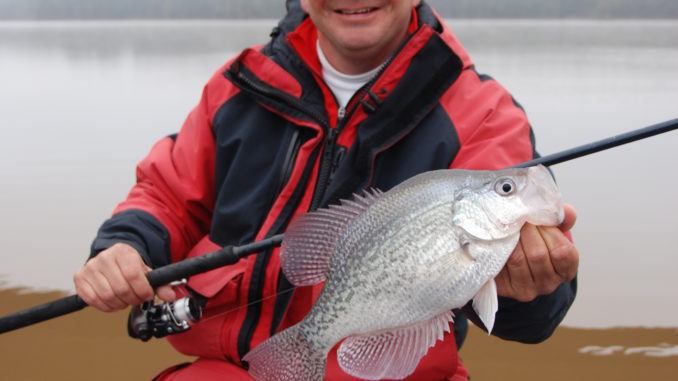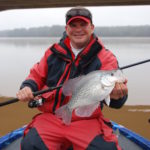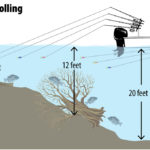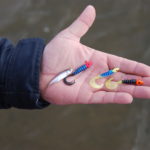
Crappie will begin their long migration to Clarks Hill Lake’s shallows this month; here’s how to keep them from getting there.
Although he lives just a hop, skip and jump from Lake Greenwood, when winter begins to wane, Rod Wall of Ninety Six much prefers to make the hour-long drive southwest to fish on his favorite crappie lake: Clarks Hill.
Clarks Hill, aka Lake Thurmond, is a much bigger lake than Greenwood, and it’s the long, sprawling creek arms in the upper half of the reservoir that get Wall excited this month when crappie begin to stir as the prespawn period approaches.
Wall, director of the Georgia-Lina Crappie Club, once said crappie start the journey from their deep-water, winter to their spawning grounds, like 1970s hippies out on the highway headed to Woodstock — the living is free and easy.
“Crappie are my favorite fish to target because they are so much more consistent,” he said. “They are not as apt to migrate and move as fast as largemouth bass will. Largemouth or striped bass will move in and out of shallow water overnight. Crappie are more reliable; if you find a good school or group of crappie, they’re going to be there the next day.”
Another reason Wall prefers crappie is his affinity for long-line trolling. Several aspects of crappie behavior make them more susceptible to long-lining. He said that even though clear water is at the top of the black crappie’s preference list, it’s finding areas of stained water in a clear lake that’s a great setup for long-lining.
“Long-line trolling is a very popular tactic on many lakes, and following frequent spring rains when the water gets some color to it, crappie will start to suspend,” he said. “That puts them right in the crosshairs for anglers who long-line troll or pull — or whatever you want to call it. Anytime you can use multiple poles and multiple baits to fish multiple depths in the water column will be catching crappie from now until the fish finish spawning and head back out.”
Wall also notes another trait that crappie exhibit as the spawn peaks over the horizon. Fish will transition from tightly packed schools in the winter to a more loosely associated migration into major tributaries that eventually leads to their spawning grounds in the shallows.
“As the water temperature rises into the low 50s and toward the middle 50s, that’s when these fish are really going to get into their spawning group, and they’re really going to start to search,” he said. “They’re going to be feeding heavily. They’ll be really scattered, so long-line trolling becomes one of the most-productive ways to find scattered fish throughout the day.”
When long-lining, Wall’s boat resembles a shrimp trawler, with as many as a dozen lines trailing through the water. From a distance, the setup may look random, but Wall carefully orchestrates it using a number of rods organized by length.
“I use a very sensitive series of rods in 8-, 9- and 10-foot lengths off the rear of the boat, and then I use some longer and stiffer-action rods in up to 18 feet off the side of the boat,” he said. “That allows me to cover about a 40- to 45-foot swath (of water) as I’m trolling through the area.”
Another piece of the puzzle is depth, which is achieved by a combination of boat speed, jig weight and line in the water. Though he may use his trolling motor to speed up and slow down to target crappie he’s marking on his depth finder, Wall’s baseline speed is .8 mph. From there, the weight of jigs fine-tunes the depth.
“My variety of weights run from 1/64-ounce all the way up to 1/8-ounce,” he said. “Probably, if I had to pick one size jig head for crappie, it would be a 1/16-ounce with a No. 2 hook. That’s going to pretty much be a standard size that you would troll with. ] I don’t like to get too small a hook when I’m long-lining.”
Finally, the jig trailer dictates much about the action of the jig and the action he’ll see from fish. Showing a decided preference for soft-plastic curlytails, Wall said changing colors and keeping track of how each produces is how to keep bites going throughout the day.
“I keep 200-plus color combinations on my boat,” he said. “Crappie have a tendency toward a favorite jig color on certain lakes. I could probably pick out 20 or 25 colors that would work just about any time on a multitude of lakes, but there are going to be times when the bigger fish may be targeting one specific color. For what reason, I don’t know. Maybe it’s just the way they’re seeing the baitfish in that color of water or whatnot. I let them tell me what to use.”
DESTINATION INFORMATION
HOW TO GET THERE — Clarks Hill, aka Lake Thurmond, lies downstream from Hartwell and Russell on the Savannah River. On the South Carolina side, the lake spans from just below Calhoun Falls down to the town of Clarks Hill. SC 28 parallels the length of the lake between these two towns. The U.S. Army Corps of Engineers maintains the majority of the public boat ramps on the lake; locate them here: www.sas.usace.army.mil/lakes/thurmond.
WHEN TO GO — Long-line trolling for crappie kicks off in late January. Crappie will start moving up major tributaries when the water temperature reaches 50 degrees.
BEST TECHNIQUES — Crappie will often suspend just under the surface during warm spells or as winter wanes and the amount of sunlight increases daily, warming the surface waters. Look for pods of baitfish on your depth finder, as crappie may be suspended in the baitfish or be so shallow they are hard to mark on a graph. Long-liners fare best using single or tandem jigs on 4- to 6-pound monofilament trolled at a variety of depths. It is important to make note of what combinations of trolling speed, line out and jig weight get bites along with specific colors.
FISHING INFO/GUIDES — Georgia-Lina Crappie Club, 864-993-8868, www.facebook.com/Georgia-Lina-Crappie-Club. See also Guides and Charters in Classifieds.
ACCOMMODATIONS — For cabins, hotel rooms and campsights, Hickory Knob State Park, www.southcarolinaparks.com/hickoryknob/introduction; McCormick County Visitors Center, 864-852-3216, mccormickscchamber.org.
MAPS — Navionics Electronic Charts, 800-848-5896, www.navionics.com. Delorme S.C. Atlas and Gazetteer, 800-561-5105, www.delorme.com; Fishing Hot Spots, 800-ALL-MAPS, www.fishinghotspots.com; Kingfisher Maps, 800-326-0257, www.kfmaps.com.




